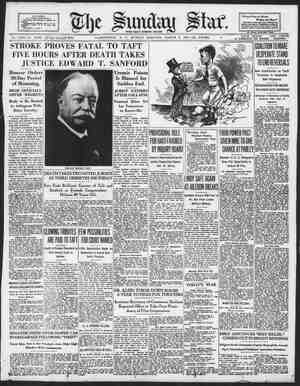Evening Star Newspaper, March 9, 1930, Page 85
You have reached the hourly page view limit. Unlock higher limit to our entire archive!
Subscribers enjoy higher page view limit, downloads, and exclusive features.
Fiction Art PART SEVEN. Magasine WASHINGTON, D. C., SUNDAY, MARCH 9, 1930. The Sundly Stad Features | B(;)-ks 24 PAGES. “Forest and Water,” Just Completed by the Of fice of Motion Pictures of the United States Department of Agriculture, Is the First Talking Picture Attempted by the Government. BY JAMES NEVIN MILLER. USIC, sound effects and the pleas- ; ing voice of an experienced actor ' are heard in “Forest and Water,” movel experimental movie just completed by the office of motion pictures, United States Department of Agricul- ture. This is the very first sound picture attempted by any branch of our Government and as such probably is Uncle Sam’s most important experi- ment in the movie field for over a decade. Right now, we are told by C. A. Lindstrom, associate chief of the office, that thousands of Government-made silent cinemas are being shown, free of charge, throughout the remote rural regions of this country, and, with the new impetus given to such motion pictures by the welcome addition of sound, their value as an entertainment and educational medium will be enhanced to a tremendous degree. More- over, foreign countries, who bought last year & total of 387 pictures from the Department of Agriculture’ alone, likewise are expected to take kindly to our new synchronized fllms. “Most of us will recall reading,” Mr. Lind- strom explains, “a couple of years ago, whem the ‘talkies’ first made their debut in Holly- wood, of the many difficulties experienced by the big producers toward achieving a first- class synchronization of sound and motion. The chaos and confusion resulting from this situ- ation lead inevitably to a rather mediocre type of picture during those trying, experimental stages of the new art. However, surprisingly soon the sound films started to improve so far as technical excellence was concerned. “Similarly, our movie men experienced & period of uncertainty in launching plans for their first sound pictures. Should they con- fine themselves to music and sound effects? Or try to produce an ‘all-talkie’? And if the latter, should they have the voice come from all the characters presented, or keep some of them silent?” R. LINDSTROM goes on to point out that before attempting a definite solution of these A certain Government-controlled company, for instance, had hit upon the plan of filming short subjects showing famous college professors giving speeches in the particular line of study which had given them renown. In many ways these films were an excellent example of how not to do the sound film. Edward Kelly (left) director of Forest and Water, and Cameraman Eugene Tucker. While the voices might have been acceptable for ordinary purposes of speech-making, they were none too satisfactory when recorded, pro- ducing a heavy and ponderous effect. More- over, the gestures and facial expressions were not particularly graceful and at times the film was somewhat out of synchronization, seri- ously impairing the audience’s interest in the famous name and message of the speaker. It was now obvious to Mr. Raymond Evans, chief of the office of motion pictures, Depart- ment of Agriculture, that if he were to utilize ERE E EE; | I " !i §E SEECET HiT efsd? Esgigaé SEAEsEE ?EE%?Q 1h o il I §E s e : g 3 % : g g %1 New York at some 2§ £ Mr. Evans had a definite procedure breathed easier. First of all, he a projection apparatus that works e disc system, which is to say that the rtion of a “talkie” is recorded on discs t like phonograph records. Whereupon to be projected on the screen is put table and a flexible drive shaft cone riving mechanism of the motion pice projector with this turntable, thereby turne gaEpises L g g employs the familiar radio n.ethod of ame cation—the sound effects issue forth from BEEE BE é g § : g i % 3 : 4 : E : ; According to Mr. Lindstrom, who is Mr, Evans’ associate, it is understood that in the near future the Government will make thorough tests of the other well known types of projece tion apparatus for sound films, notably, of the kind wherein the “talkie” effects are connected MOST of the silent interiors for “Forest and Water” were taken in the spacious movie Iaboratories of the Department of Agriculture in Washington. However, the exteriors were “shot” in many widely divergent sections of the land, including Maine, New Hampshire, Weste ern North Carolina, Virginia and West Virginis, Many scenes of remarkable scenic beauty were filmed, since the aim of the picture, which is allegorical in treatment, is to stimulate every one who sees it to a better appreciation of the public need for conserving carefully our valuae ble timber and water resources. There are strik= ing shots of forest fires and their attendant damage, besides scenes showing the terrific deve astation of floods. : A couplé of speeches, gleaned verbatim from the new sound films, are these: “As it flows,
